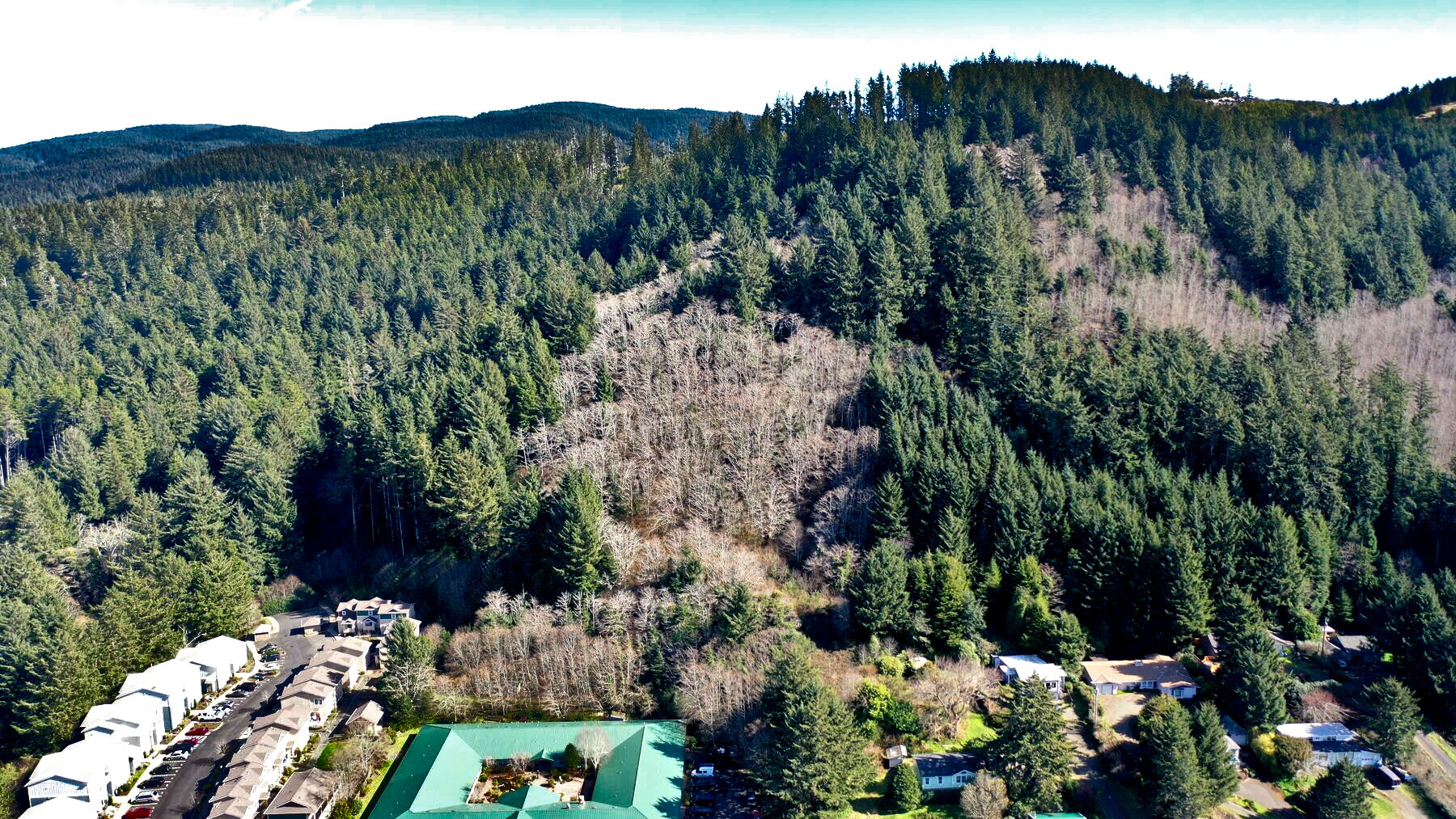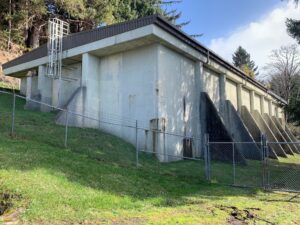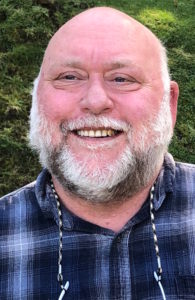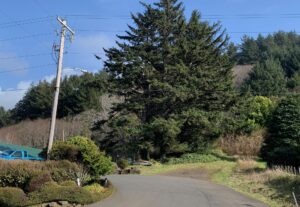
By GARRET JAROS/YachatsNews
YACHATS – When it comes to planning for the future of Yachats two issues always rise to the top – water sustainability and affordable housing.
A project that could combine both objectives is currently in the works. But city officials caution there are a lot of unknowns as they assess a wooded property for its potential to become the home of both a 1.5 million gallon water reservoir and workforce/middle-income housing.
But even if the ground is suitable for a reservoir and housing and funding is secured, the project is years out.
“It is really big picture stuff right now,” said Yachats city manager Bobbi Price. “It would be a multi-year, multi-phase, big project. Regardless if homes are built there or not, we absolutely have to find another location for a safe water tank. Homes are years away. The tank is No. 1. And then anything we are able to do as far as workforce housing lots on top of that is an additional great thing for the community – icing on the cake.”

The realization that Yachats needed to find a new location for a water tank came after the completion of a 2021 water master plan. A seismic study determined the ground under a 1 million gallon concrete reservoir high on Radar Road is not stable enough to withstand a moderate to severe earthquake. The reservoir was built in 1991.
“So we are focused on the water tank part of it right now for public safety and our water sustainability,” Price said. “The tank is something we definitely could do a retrofit to make it seismically safe. But the ground underneath – they said it would liquify.”
The seismic study determined the Radar Road tank sits atop an old landslide about 10 to 15 feet above stable ground and would probably cave in on itself if the ground gave away. That led water supervisor Rick McClung to begin casting about for a new location.
“We could seismically fix it up but that won’t stop it from sliding down the hill because of the bad ground,” McClung said. “So I was thinking ‘What do we do?’ I don’t want to throw a bunch of money at nothing.”

McClung pored over topographical maps with the knowledge a new tank will need to be at an elevation of 220 feet in order to function properly with the current system. It is also a lot easier and affordable if the tank stays on the north side of the Yachats River.
“After looking over the maps I realized we have a pretty tight footprint of residents,” McClung said. “There’s not a whole lot of places at 220 feet to build a reservoir that hasn’t had previous slides or is just not a good spot.”
Then he started looking at eight acres of empty land owned by developer Layne Morrill on the hillside behind Sea Aire Assisted Living in north Yachats. He knew Morrill wanted to build affordable housing on the site but that the lack of infrastructure made it unworkable.
Morrill is an experienced developer of affordable housing projects. In Yachats, he built the adjacent 21-unit Fisterra Gardens Townhomes, the seven-unit Aqua Vista Square Apartments and a 24-unit project in Florence.
That led to talks about some sort of trade with Morrill with the city supplying infrastructure for housing in return for land to locate its water tank. Those talks eventually boiled down to buying the property from Morrill.
“If it is deemed to be in the city’s best interest, the price tag would be about $20,000 a lot or about $770,000 for 35 housing lots and the location for the water tank,” Price said. “And then the cost of infrastructure, which could be very expensive.”
The city’s next step is to carve a road – possibly in late April or May when the ground dries – from a spur at the south end of Sea Aire’s driveway to a likely location for a concrete reservoir.
Once the road is in, engineers will determine if the ground is suitable for a reservoir and whether the steep slopes on the property are suitable for a housing development.
If built, the new reservoir would hold 1.5 million gallons and increase the city’s water storage capacity by 300,000 gallons after the Radar Road reservoir and the city’s original 80-year-old 200,000 gallon reservoir are decommissioned.

The housing issues
Mayor Craig Berdie mentioned the property as a possible location for workforce and middle-income housing at the annual state of the city presentation in February.
“One thing to be clear about is we don’t want to get too far over our skis on the whole thing,” Berdie told YachatsNews. “We are trying to be as transparent as possible. We will be cutting a road in so we can do the geological study and it’s best to be up front about why that’s going in versus people making up all kinds of stories about it.”
The city is already applying for federal funding to pay for the project as well as contacting state-funded housing programs.
“I would like to see a mix of housing,” Berdie said. “Everything from apartment rentals to various-sized housing for purchase and maybe for rent. And if it worked out, some form of day care also. If you’re going to do workforce housing you need to think about daycare …”

The city has been studying how to create more workforce housing through code and ordinance changes that would allow for multiple families to live in a single home as well as changes in density and parking regulations.
It also collaborated with the Yachats Chamber of Commerce to conduct a workforce housing survey in September that asked local workers and employers what kind of housing was desired. The answer was a variety of housing types.
The Planning Commission has also been talking about rules for additional dwelling units – called ADUs — which could be as straightforward as a simple remodel on a large house to creating small, separate structures.
“What I like to think about is that if people do have that kind of situation and we get to this point where we’ve allowed more ADUs to be multi types, not just the tiny house put in your backyard, but turning lower levels into an additional rentable house or apartment – to me that makes sense,” Price said in October. “It would allow our population to age in place and have an additional income source.”
The most recent median purchase price of a home in Yachats was $795,000 and the median monthly rental cost for a single-family home was $4,399, according to Altos Research, a market researcher used by Lincoln County realtors. The median home price in Lincoln County is $642,000 and a single-home rental was $2,800 a month. Those amounts are based on current availability only.
How to pay for it
If the Morrill property is deemed suitable for a reservoir and housing, Price said the city would explore “multi-dimensional housing.”

“There might be tiny house lots,” Price said. “We would want to do houses for sale. We would want some for rent. We’d want different types of housing rather than a monoculture. Some affordable, some middle-income, some workforce, maybe some market rate to balance it out. But that is so big picture, visionary right now.”
But again, she stressed, it is all in the feasibility process now — including discussions with the landowner and finding money.
Price is talking with state agencies that work with cities to provide revolving loans to build housing. One in particular is called the “moderate income revolving loan.”
“How that is structured is the city would take the loan from the state and then would loan it to the developer to do the build at a subsidized rate and they would repay back the state,” Price said.
To ensure housing was used for local workers and not end up as second homes, Price foresees the city placing a covenant on the land.
“Anything that was sold would have to be for someone working in Yachats,” Price said. “You can get pretty specific with a covenant on the land. And then whoever purchases it the first time, when they sell, they can get one or two percent on their equity per year that they are there and then it keeps it in that moderate to medium, middle-income housing.
“So that’s what we would do, put some restrictions on the land to work with the developers,” she concluded. “And then we would probably put it in the developer’s hands.”
- Garret Jaros covers the communities of Yachats, Waldport, south Lincoln County and natural resources issues for YachatsNews and can be reached at GJaros@YachatsNews.com




















You would think that the city had this information when they built the plant in 1991. The ground hasn’t changed!
The first evidence of the Cascadia subduction zone’s potential for magnitude 9 earthquakes came in the early 1980s and it was not until about 1995 there was consensus in the scientific community on the threat. So my guess is no one was thinking earthquakes or the landslides they might trigger back in 1991, though you would think a surficial historic landslide should have been mapped.